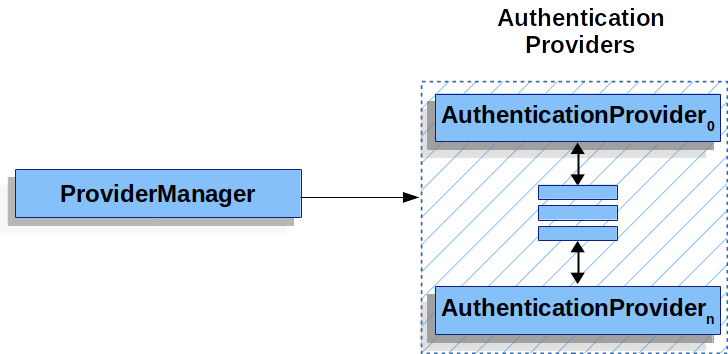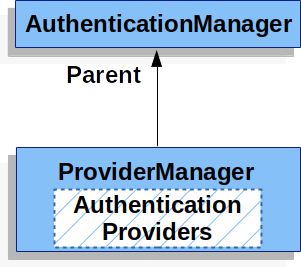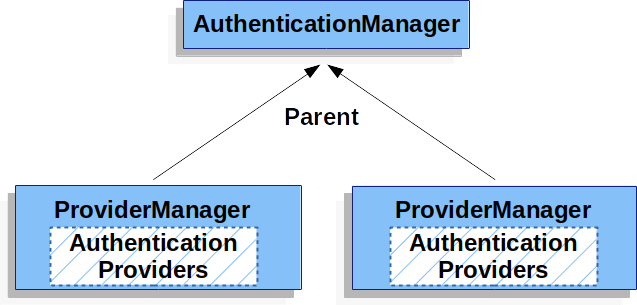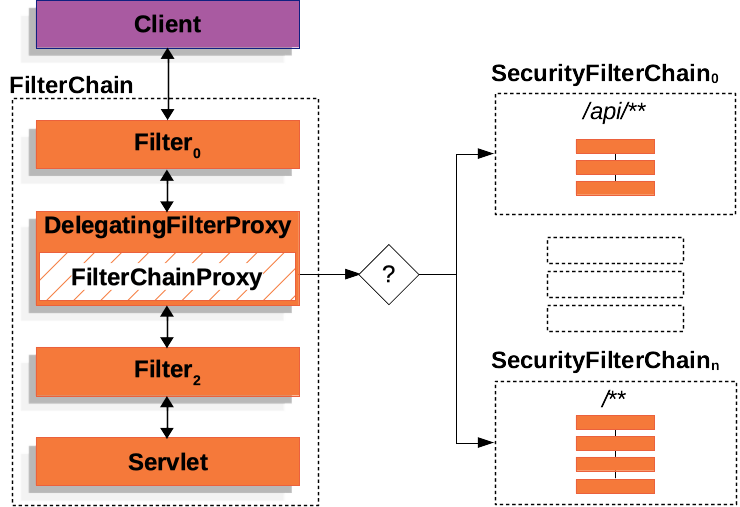Spring Security (9) ProviderManager
Intro
AuthenticationManager 에 대해서 다뤘던 이전 글에 이서 ProviderManager 를 살펴보겠습니다.
ProviderManager
이전 글에서 살펴본 Provider Manager
이전 글 마지막에 문서(링크)를 살펴보며 ProviderManager는 AuthenticationManager 의 가장 흔히 사용되는 구현이고, ProviderManager는 AuthenticationProviders 에 위임한다는 것을 아래 그림과 함께 확인했습니다.
ProviderManager의 전체적인 동작 흐름
이어서 나오는 ProviderManager 관련 내용을 살펴보면, 아래와 같습니다.
Each
AuthenticationProviderhas an opportunity to indicate that authentication should be successful, fail, or indicate it cannot make a decision and allow a downstreamAuthenticationProviderto decide. If none of the configuredAuthenticationProviderinstances can authenticate, authentication fails with aProviderNotFoundException, which is a specialAuthenticationExceptionthat indicates that theProviderManagerwas not configured to support the type ofAuthenticationthat was passed into it.
각 AuthenticationProvider는 인증의 성공, 실패, 보류 여부를 결정하거나 다음 AuthenticationProvider가 결정하게 할 수 있다고 합니다. (Filter 생각나게 하는 패턴입니다.) 그리고 인증 대상인 Authentication 객체가 ProviderManager에 있는 AuthenticationProvider 중에 인증을 할 수 있는 AuthenticationProvider가 없으면 AuthenticationException 중에 하나인 ProviderNotFoundException 과 함께 인증에 실패한다고 합니다.
이전에 Authentication 과 관련된 글(링크)에서 봤던 Authentication 객체에 저장된 정보(Credentials, Principals)를 가지고, 인증 작업을 수행하는 구체적인 과정을 AuthenticationProvider에서 수행할 것으로 유추해볼 수 있습니다.
문서에서도 바로 뒤에 각 AuthenticaionProvider 가 특정 유형의 인증을 수행하는 방법을 알고 있고, 특정 유형의 구체적인 예로는 username/password 의 검증이나 SAML assertion 을 인증을 들고 있습니다.
ProviderManager가 여러 개인 경우
AuthenticationManager Bean만 노출한 채로 여러 AuthenticationProvider 를 통해 여러 유형의 인증을 지원할 수 있다는 언급도 하고 있습니다.
갑자기 또 ProviderManager의 부모인 AuthenticationManager 를 언급하는 이유는, 현재 ProviderManager 내 에서 인증을 수행할 수 있는 AuthenticationProviders 가 없는 경우 다른 AuthenticaionManager 의 구현을 참조하도록 설정할 수 있기 때문입니다. 이와 같은 경우 아래 그림과 같은 구조가 됩니다. 하지만 Option일 뿐 강제사항은 아닙니다.
다음과 같이 ProviderManager(Github 링크)에는 parent AuthenticationManager 는 선택적으로 사용할 수 있도록 Constructor 가 정의되어 있습니다.
1
2
3
4
5
6
7
8
9
10
11
12
13
14
15
// ProviderManager.java
public ProviderManager(AuthenticationProvider... providers) {
this(Arrays.asList(providers), null);
}
public ProviderManager(List<AuthenticationProvider> providers) {
this(providers, null);
}
public ProviderManager(List<AuthenticationProvider> providers, AuthenticationManager parent) {
Assert.notNull(providers, "providers list cannot be null");
this.providers = providers;
this.parent = parent;
checkState();
}
문서에서는 일부 인증(공유된 부모 AuthenticationManager)은 공통적이지만 인증 메커니즘(다른 ProviderManager 인스턴스)이 다른 여러 SecurityFilterChain(관련 글) 인스턴스가 있는 시나리오에서 ProviderManager가 여러개 인 것이 어느 정도 일반적인 경우라고 합니다.
주의 사항
문서에서 ProviderManager 의 마지막 문단을 살펴보겠습니다.
기본적으로 ProviderManager는 성공적인 인증 요청에 의해 반환되는 Authentication 객체에서 민감한 자격 증명(credentials) 정보를 지우려고 시도합니다. 이렇게 하면 비밀번호와 같은 정보가 HttpSession에서 필요 이상으로 오래 유지되는 것을 방지할 수 있습니다.
그리고 이렇게 Credentials를 제거하는 경우, 캐시를 사용할 때 문제가 됨을 언급하고 있습니다. 구체적인 예로는 stateless 앱에서 사용자 객체 정보(문서에서 UserDetails 를 예로들었는데 이 객체는 아직 나온적 없으므로, 나중에 관련 정보를 추가하겠습니다.)를 캐시해놓고 사용할 때 Credentials가 지워져 버린 경우 더 이상 캐시된 값에 대해 인증할 수 없는 상황을 이야기합니다.
그리고 이러한 문제의 해결책으로, 아래 두 가지를 제시합니다.
- cache implementation 또는 반환된 Authentication 객체를 생성하는 AuthenticationProvider 에서 객체의 복사본 만들기
- ProviderManager에서 eraseCredentialsAfterAuthentication 속성 비활성화
1번의 경우 아직 와닿는게 없습니다만, Credentials 를 갖고 있는 Authentication 객체를 복사해두고 인증 시에 사용하는 것으로 생각됩니다. 자세한 정보를 얻으면 추후에 추가하겠습니다.
2번 같은 경우 간단하게 메서드를 호출해서 설정할 수 있습니다.
1
2
3
public void setEraseCredentialsAfterAuthentication(boolean eraseSecretData) {
this.eraseCredentialsAfterAuthentication = eraseSecretData;
}
그런데 굳이 1번처럼 복잡하게 하기보다는 간단하게 2번을 호출하는게 개인적으로는 더 좋아보입니다.
Event Publishing
ProviderManager의 API 문서(링크)를 보면, Event Publishing 에 관한 이야기가 나옵니다.
AuthenticationEventPublisher 에 대해서 문서에서 별도로 다루고 있어(링크), 때가 되면 별도의 글로 작성해 보겠습니다.
정리
ProviderManager 도 구체적인 인증 절차는 AuthenticationProvider 로 넘기기 때문에, 그냥 이런게 있구나 하면서 가볍게 살펴봤습니다.
전체적인 흐름을 러프하게 정리해보면 ProviderManager 가 Authentication 객체를 받아서 해당 Authentication을 처리할 수 있는 AuthenticationProvider 로 넘겨 인증 절차를 수행합니다.
- 인증에 성공한 경우: ProviderManager는 기본적으로 Credentials 를 지우고 Authentication 객체를 반환하므로, stateless 앱에서 캐시를 사용하는 경우 setEraseCredentialsAfterAuthentication 메서드로 인증에 사용할 Credentials를 지우지 않게 하는 등의 원활한 인증을 위한 조치를 취해주어야 합니다.
- 인증에 실패한 경우: AuthenticationException 을 던집니다. 만약 ProviderManager에 있는 AuthenticationProvider 중에 입력된 Authentication 을 인증할 수 있는 AuthenticationProvider가 없다면, ProviderNotFoundException 을 던집니다. 이때 여러 개의 ProviderManager 를 사용하면서, 동일한 Parent AuthenticationManager를 갖는 경우 parent를 설정하여 다른 ProviderManager 로 인증 절차를 넘길 수도 있습니다.
- 판단할 수 없는 경우: 다음 AuthenticationProvider로 넘길 수 있습니다.
Outro
다음에 살펴봐야 할 AuthenticationProvider 는 문서 상에 설명이 두 문장 밖에 없지만, 지금 사용하고 있는 AuthenticationProvider 를 구체적으로 살펴보고 싶어서 다음 글로 넘기려고 합니다.
그럼 다음은 실제 인증을 수행하는 AuthenticationProvider 를 살펴보겠습니다.



